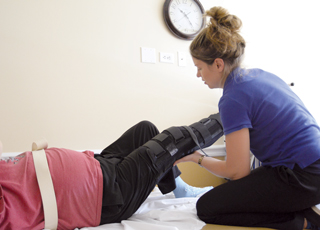
It’s possible that nothing will be more impactful on long-term care this year than looming changes to the way therapy services are reimbursed by the Medicare program.
The proposed Resident Classification System, Version 1, or “RCS-1,” promises to be the most significant development since the advent of the prospective payment system in 1998. The new system could go into effect as early as October.
Observers say RCS-1 marks a radical departure from the current PPS model. If passed as now proposed, gone will be the case-mix classification model of resource utilization groups.
Cynthia K. Morton, executive vice president of the National Association for the Support of Long Term Care, notes that the Medicare Payment Advisory Commission and the Centers for Medicare & Medicaid Services have been seeking to change course for about five years.
“MedPAC argues there needs to be changes to the reimbursement system because they feel the amount of therapy provided drives the reimbursement,” she says. “CMS wants nursing to drive reimbursement.
“I think the agency felt they were paying for services a la carte and wanted to modernize the payment system,” she adds. “Doing so would most likely move it to an episodic or bundled payment, but curiously, CMS did not propose that. It’s still a per diem arrangement. Perhaps this is a step toward episodic payments in the future. In some respects, they’re trying to de-emphasize therapy, while rehab therapy, as well as nursing, is what gets the results in terms of outcomes. All these pieces of care are important.”
Morton stresses that under the RCS-1 model, providers continue receiving a per diem based on evaluation of the patient’s clinical, functional and cognitive needs. The model has the provider assess the patient on these three areas.
Huge change
RCS-1 signals a radical shift fueled by healthcare reform, says Paul Riccio, vice president of nance and development for Vertis Therapy.
“From a budget perspective alone, the rise in therapy volume necessitated a move from a volume system to an outcomes system,” he says.
Matthew Mesibov, PT, GCS, clinical physical therapy specialist for Centrex Rehab, believes CMS’ “concerns about overutilization, payment accuracy, and access for medically complex patients” signals the agency’s drive toward value-based payment initiatives.
“In a future payment system such as RCS-1, it is likely we will see the connection between therapy utilization and payment eliminated,” he adds.
CMS has made clear its three main goals for the new payment system will be more accurately compensating skilled nursing facilities, focusing justification for therapy on resident need, and maintaining simplicity. Whatever the impetus, the proposal leaves little doubt that financial incentives for therapy will shift.
The Center for Medicare Advocacy proclaims RCS-1 would “gut therapy” in long-term care. But many industry experts say the evolutionary change has been long in the works.
“This shift will force a top-down look at every single department inside a nursing home — from dietary to housekeeping,” Riccio says.
The ‘minutes’ debate
A major change in the proposed payment system is the near-abolition of reimbursement based on “therapy minutes.” Industry reaction to that is mixed, given how much time has been focused on minutes, notes Jean Wendland Porter, PT, CCI, WCC, CKTP, CDP, TWD, Diversified Health Partners’ Regional Director of Therapy Operations in Ohio.
Good providers have always focused on patients’ needs, with many going well beyond the 720- and 500-minute threshold for High and Ultra High RUG residents, she says.
“Now there’s a very good chance we’re not going to look at minutes at all,” Porter says. “We need to look at other ways to adapt. RCS-1 will allow us to focus with other entities more cohesively and comprehensively. Our adaptation will be to continue to serve the patient to the best of our abilities, but we will work closely with other services as well to ensure payment.”
Like Porter, Mesibov is understandably conflicted about the end of minute counting.
“I would expect challenges because counting time is an easy method to equate to reimbursement and it does reflect an amount of time spent working,” he says. “However, clinically, it is not just about the number of minutes but rather how you work with patients when you intervene with them in those minutes. It should be about sound clinical judgment applied to a given set of patient characteristics and the outcome of these interventions.”
Others believe removing financial incentives around volume would eventually lead to better, more focused care.
“Gone will be the days when the rehab company gets compensated on units of time,” Riccio says. “In moving to an outcomes- based model, financial risks are being shifted to the provider, which now has a more vested interest in the patient’s success. Long-term, I think this will pave the way economically and societally to have a more sustainable industry because to accept this change, we have to acknowledge that the current budget is not sustainable.”
Mark Besch, chief clinical officer for Aegis, believes the “minutes” issue remains “open to a lot of speculation as to how it will affect overall industry practices. Really, providers could do several things. What they should do is an entirely separate conversation; and what they will do is a real unknown.”
Some predict the demand for therapists will decrease under RCS-1, at least for the short term.
There are other major expected points.
Attrition: Most believe the new rules will slightly thin the therapy provider ranks.
Riccio believes a level of clinical skill and engagement and a level of technology proficiency will be required to survive.
Besch doesn’t see a dramatic level of attrition simply because “patients today are more complex with more rehab needs.”
Therapy outcomes: Morton points out that while the pro- posed RCS-1 model “is not directly tied to any kind of outcomes or value base,” current quality and value-based purchasing measures will ensure providers stay focused on achieving better outcomes.
The pressures are substantial.
“Operators are going to under-go a major reimbursement model change at the same time quality measures are being amped up,” Morton notes.
“The focus on quality for the community will likely not lead to an increase of poor outcomes,” adds Larry Lemberger, national sales manager for Biodex Medical Systems. “It’s just how they get there without rehab.”
Most believe incentives and mandates on quality measures will help ensure better outcomes, regardless of reimbursement.
“The patients we see today are the same ones we’re seeing tomorrow,” Morton says. “Operators that feel they’ve seen an advantage in a payment model to provide less care are not going to score well on these quality measures. Those measures are only going to get more refined and more specific tomorrow.
She adds “smart operators” study measures and want to provide quality care.
Those measures are what providers are being held to, even with less therapy, adds Martha Schram, president and CEO of Aegis Therapies. “Providers are going to be more accountable and their reimbursement more affected by outcomes.”
A rise in group/concurrent therapy: RCS-1 proposals offer incentives around group and concurrent therapy, an attractive option. Riccio believes “group and concurrent therapy will become an economic and clinical necessity because without it, I don’t think it will be possible to hit the out- comes under this new system and stay in business.”
Most welcome the change, even though current proposals would cap the amount provided at 25%.
Strategies to succeed
Morton believes the new payment rules will require SNFs and their therapy partners to collaborate more closely than ever before.
“The patients aren’t going to change. The rules of engagement between SNFs and therapy providers will,” she says, advising providers to fully understand how the model classifies the patient in terms of the clinical, functional and cognitive characteristics.
“The need for interdisciplinary communication is unlike anything we’ve ever seen,” adds Riccio. “And fairly soon, the SNF is going to look to the therapy provider to share its risk. That’s where smart therapy providers are going to get involved early on with new contract structures that share risk with the SNF in an intelligent way.”
Riccio also advises providers to explore and participate in as alternative payment models, while Schram believes highly valued therapists will be those with demonstrated competencies.
“It is incredibly important to understand how I organize and coordinate services in a timely fashion and to be clear on what I’m really good at because payment for long lengths of stay will be declining,” she says.
Lemberger adds that providers that are centers of excellence for specific patient classifications because of proven outcomes “can expand their referral base and gain a competitive advantage.”
RCS-1 provides an opportunity to integrate new technologies into the practice of therapy “that a one-on-one minutes environment didn’t provide for,” says Peter Klug, category director, healthcare clinical and rehabilitation for Direct Supply, Inc.
“In a payment model that doesn’t allow for reimbursement based on minutes, technology may be able to expand a therapist’s ability to provide more comprehensive and holistic care,” he adds.
But whether it’s new technology or value-based models, at the end of the day providers should prioritize individual needs, Porter says.
“It’s important to focus on the patient,” she says. “If you do the right thing for the patient, the payment will follow.”
From the February 01, 2018 Issue of McKnight's Long-Term Care News





